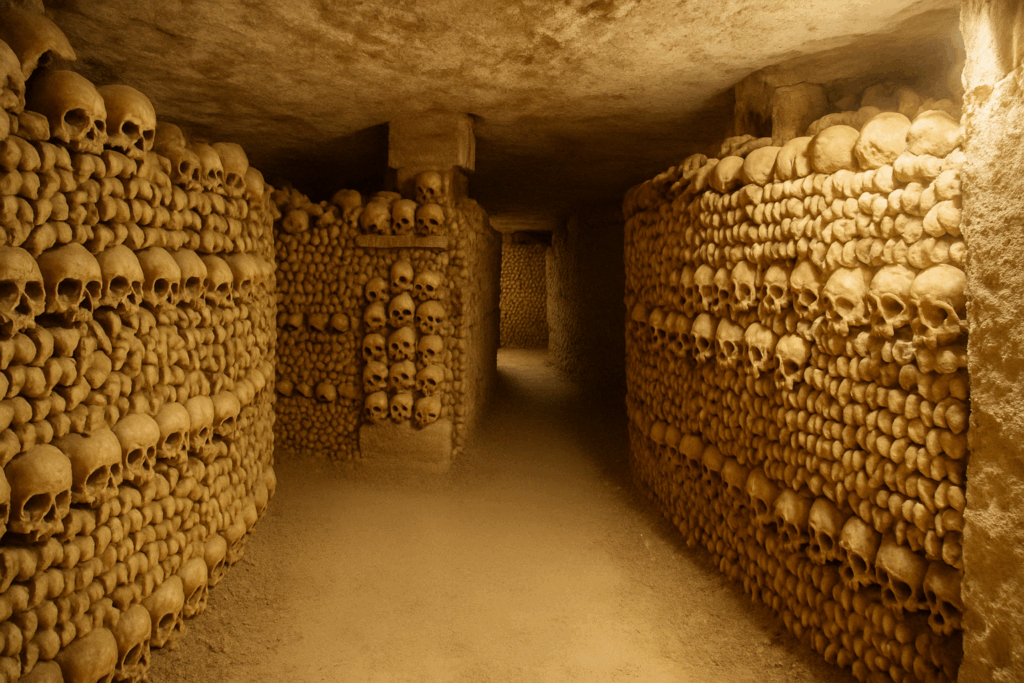
Beneath the romantic boulevards and glittering lights of Paris lies a far more macabre mirror of the city — a sprawling, bone-lined labyrinth known as the Catacombs of Paris. This underground ossuary holds the remains of more than six million souls, quietly resting in shadowed tunnels carved from the city’s limestone bedrock.
Once used as ancient quarries, these catacombs now serve as one of the world’s most haunting — and fascinating — reminders of mortality, urban evolution, and the sheer scale of human history.
The Origins: From Quarries to Crypts
Long before the catacombs became an ossuary, the tunnels were limestone quarries used to build many of Paris’s most iconic structures, including Notre-Dame Cathedral and The Louvre. These tunnels crisscrossed the city’s subsoil for miles, forming a vast subterranean network.
By the 18th century, Paris faced a grim crisis: overcrowded cemeteries. With limited space and poor burial practices, the city’s graveyards overflowed, causing disease, structural collapse, and unbearable stench in surrounding neighborhoods.
The Great Transfer of the Dead
In 1786, city officials made a bold decision — to move the contents of Paris’s cemeteries underground. Bones from Cimetière des Innocents (the largest cemetery at the time) were carefully transported to the quarries over several years under the cover of night.
The bones were not simply dumped; they were arranged in decorative patterns, with skulls and femurs stacked into walls and pillars. These arrangements weren’t just practical — they became symbolic, reflecting themes of death, rebirth, and the fragility of life.
Designing the Empire of the Dead
The man credited with transforming the catacombs into a memorial is Louis-Étienne Héricart de Thury, who in the early 1800s began the process of organizing the bones and adding poetic inscriptions. His work turned the chaotic bone piles into the solemn galleries we see today.
Carved into stone throughout the tunnels are eerie quotes such as:
“Arrête! C’est ici l’empire de la mort.”
“Stop! This is the empire of the dead.”
These chilling reminders guide visitors through a place where art and anatomy collide.
A Forbidden World Below
While a small section of the catacombs is open to the public today, the majority of the underground network is off-limits — and that’s where things get even more mysterious. These hidden tunnels, referred to by urban explorers as “les cataphiles,” contain secret chambers, murals, sculptures, makeshift cinemas, and even illicit concerts.
Despite police patrols and legal restrictions, cataphiles continue to explore and document the unknown corridors, often entering through hidden entrances in metro stations, sewers, or abandoned buildings.
Legends and Lost Souls
The Catacombs have no shortage of legends. Perhaps the most infamous is the story of a man named Philippe Leduc, whose camcorder was found in the 1990s deep within the restricted areas — containing footage of him becoming lost and panicked. He was never found. His story became the inspiration for the horror film As Above, So Below.
Visitors and explorers often report strange sounds — whispers, laughter, or footsteps — deep in the darkness. Whether it’s urban myth or something more, the Catacombs maintain an aura of unshakable eeriness.
Art, Death, and Meaning
More than just a tourist attraction or morbid curiosity, the Catacombs of Paris serve as a powerful reflection on death and legacy. Every skull belonged to someone with a story — a life, a dream, a heartbreak.
The Catacombs challenge our ideas of mortality, beauty, and space. They force us to consider the weight of human life — not in numbers, but in the sheer physical presence of six million bones beneath our feet.
Conclusion: A Mirror Beneath the City
The Catacombs of Paris are more than a burial site — they are a hidden city beneath the city, a physical archive of forgotten lives and urban resilience. Whether you enter as a curious tourist or an underground adventurer, you’ll leave with a deeper awareness of both history and your own humanity.
As the inscription says: “Think in the morning that you might not live until evening, and in the evening that you might not wake again.”
Hashtags
#pariscatacombs #catacombsparis #undergroundparis #historybeneathparis #ossuary #empireofthedead #secretparis #parismysteries #urbanexploration #cataphiles #skullsandbones #deathinart #quarriesofparis #hauntedparis #darktourism #macabrehistory #subterraneanparis #hiddenparis #asaboveSobelow #parishistory #cemeteryoverflow #bonesbeneath #louiseticart #ancientquarries #lostsoulsparis #parisunderground #catacombslegends #gothicparis #darkpast #deathbeneath